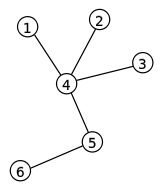prufer sequence
2015-11-12 13:41
465 查看
Prüfer sequence
From Wikipedia, the free encyclopedia(Redirected from Prufer sequence)
In combinatorial mathematics,
the Prüfer sequence (also Prüfer code or Prüfer numbers) of a labeled
tree is a unique sequence associated with the tree. The sequence for a tree on n vertices
has length n − 2, and can be generated by a simple iterative algorithm. Prüfer sequences were first used by Heinz
Prüfer to prove Cayley's formulain 1918.[1]
Contents
[hide] 1Algorithm
to convert a tree into a Prüfer sequence
1.1Example
2Algorithm
to convert a Prüfer sequence into a tree
3Cayley's
formula
4Other
applications[3]
5References
6External
links
Algorithm to convert a tree into a Prüfer sequence[edit]
One can generate a labeled tree's Prüfer sequence by iteratively removing vertices from the tree until only two vertices remain. Specifically, consider a labeled tree Twith vertices{1, 2, ..., n}. At step i, remove the leaf with the smallest label and set the ith element of the Prüfer sequence to be the label of this leaf's neighbour.
The Prüfer sequence of a labeled tree is unique and has length n − 2.
Example[edit]

A labeled tree with Prüfer sequence {4,4,4,5}.
Consider the above algorithm run on the tree shown to the right. Initially, vertex 1 is the leaf with the smallest label, so it is removed first and 4 is put in the Prüfer sequence. Vertices
2 and 3 are removed next, so 4 is added twice more. Vertex 4 is now a leaf and has the smallest label, so it is removed and we append 5 to the sequence. We are left with only two vertices, so we stop. The tree's sequence is {4,4,4,5}.
Algorithm to convert a Prüfer sequence into a tree[edit]
Let {a[1], a[2], ..., a
} be a Prüfersequence:
The tree will have
n+2nodes, numbered
from
1to
n+2.
For each node set its degree to the number of times it appears in the sequence plus 1. For instance, in pseudo-code:
Convert-Prüfer-to-Tree(a) 1 n ← length[a] 2 T ← a graph with n + 2 isolated nodes, numbered 1 to n + 2 3 degree ← an array of integers 4 for each node i in T 5 do degree[i] ← 1 6 for each value i in a 7 do degree[i] ← degree[i] + 1
Next, for each number in the sequence
a[i],
find the first (lowest-numbered) node,
j, with degree equal to 1, add the edge
(j, a[i])to the tree, and decrement the degrees of
jand
a[i].
In pseudo-code:
8 for each value i in a 9 for each node j in T 10 if degree[j] = 1 11 then Insert edge[i, j] into T 12 degree[i] ← degree[i] - 1 13 degree[j] ← degree[j] - 1 14 break
At the end of this loop two nodes with degree 1 will remain (call them
u,
v).
Lastly, add the edge
(u,v)to the tree.[2]
14 u ← v ← 0 15 for each node i in T 16 if degree[i] = 1 17 then if u = 0 18 then u ← i 19 else v ← i 20 break 21 Insert edge[u, v] into T 22 degree[u] ← degree[u] - 1 23 degree[v] ← degree[v] - 1 24 return T
Cayley's formula[edit]
The Prüfer sequence of a labeled tree on n vertices is a unique sequence of length n − 2 on the labels 1 to n — this much is clear. Somewhat less obvious is thefact that for a given sequence S of length n–2 on the labels 1 to n, there is a unique labeled tree whose Prüfer sequence is S.
The immediate consequence is that Prüfer sequences provide a bijection between
the set of labeled trees on n vertices and the set of sequences of length n–2 on the labels 1 to n. The latter set has size nn−2, so the existence of this bijection
proves Cayley's formula, i.e. that there are nn−2 labeled
trees on n vertices.
Other applications[3][edit]
Cayley's formula can be strengthened to prove the following claim:The number of spanning trees in a complete graph

with
a degree

specified for each vertex

is
equal to the multinomial coefficient

The proof follows by observing that in the Prüfer sequence number

appears
exactly

times.Cayley's formula can be generalized: a labeled tree is in fact a spanning
tree of the labeled complete graph. By placing restrictions on the enumerated Prüfer sequences,
similar methods can give the number of spanning trees of a complete bipartite graph. If G is
the complete bipartite graph with vertices 1 to n1 in one partition and vertices n1 + 1 to n in the other partition, the number of
labeled spanning trees of G is

,
where n2 = n − n1.
Generating uniformly distributed random Prüfer sequences and converting them into the corresponding trees is a straightforward method of generating uniformly distributed random labelled trees.
以上内容摘自维基百科,大意是(n-2)长度的prufer sequence能表示n个节点的树,转化方法如下,对一棵树,先把树的叶子节点中标号最小的点摘除,把他的父亲放在数列中,重复此操作,直至树只剩两个节点,attention 根不是叶子节点,反过来,对于一个数列,将其未出现在数列中的最小标号的节点作为数列首的儿子,删除数列首,重复操作,直至数列为空。可以证明,(n-2)长度的prufer
sequence与n个节点的树是一一对应的关系。
那么,n个节点的树最多为n^(n-2),
应用
1我们可以通过生成一个序列来生成一棵树,不用写并查集之类的了,同时由前文可得,一个点出现了多少次就有多少个儿子(除了根),那么我们就可以生成一个有度数要求的树,同时如果题目给定度数要求树的数目,我们就可以

直接算了
2如果在一个完全二分图上求生成树,左边n1个点,右边n2个点,最后生成树的总数为

